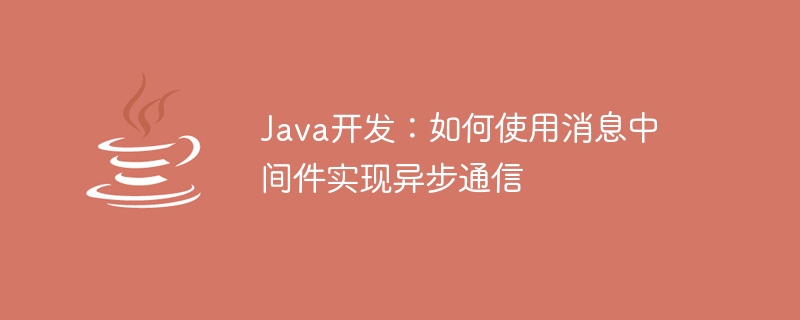

Java development: How to use message middleware to implement asynchronous communication
Introduction:
In modern application architecture, asynchronous communication has become very important. It improves application performance and scalability and enables loosely coupled component communication. Message middleware is a common way to implement asynchronous communication. This article will introduce how to use message middleware to implement asynchronous communication in Java development and provide some specific code examples.
What is message middleware?
Messaging middleware is a software solution for reliable transmission of messages in distributed systems. It uses a producer-consumer model that enables communication between different components by sending and receiving messages. Message middleware is responsible for handling details such as message delivery, persistence, and reliability, thereby reducing direct dependencies between applications.
Benefits of using message middleware:
How to use message middleware to implement asynchronous communication in Java?
The following takes the commonly used message middleware RabbitMQ as an example to demonstrate how to use message middleware to implement asynchronous communication in Java.
Step 1: Install and configure RabbitMQ
First, you need to install RabbitMQ and configure related virtual hosts, users, permissions and other information. You can refer to the RabbitMQ official documentation for detailed instructions on installation and configuration.
Step 2: Add dependencies
Add RabbitMQ's Java client dependency in the project's pom.xml file:
com.rabbitmq amqp-client 5.12.0
Step 3: Send a message
The following is a send message Sample code:
import com.rabbitmq.client.ConnectionFactory; import com.rabbitmq.client.Connection; import com.rabbitmq.client.Channel; public class MessageProducer { private final static String QUEUE_NAME = "my_queue"; public static void main(String[] args) throws Exception { // 创建连接工厂 ConnectionFactory factory = new ConnectionFactory(); factory.setHost("localhost"); // 创建连接 Connection connection = factory.newConnection(); // 创建通道 Channel channel = connection.createChannel(); // 声明并发送消息 String message = "Hello, RabbitMQ!"; channel.queueDeclare(QUEUE_NAME, false, false, false, null); channel.basicPublish("", QUEUE_NAME, null, message.getBytes("UTF-8")); System.out.println("Sent: " + message); // 关闭连接和通道 channel.close(); connection.close(); } }
Step 4: Receive the message
The following is a sample code to receive the message:
import com.rabbitmq.client.ConnectionFactory; import com.rabbitmq.client.Connection; import com.rabbitmq.client.Channel; import com.rabbitmq.client.DeliverCallback; public class MessageConsumer { private final static String QUEUE_NAME = "my_queue"; public static void main(String[] args) throws Exception { // 创建连接工厂 ConnectionFactory factory = new ConnectionFactory(); factory.setHost("localhost"); // 创建连接 Connection connection = factory.newConnection(); // 创建通道 Channel channel = connection.createChannel(); // 声明队列 channel.queueDeclare(QUEUE_NAME, false, false, false, null); System.out.println("Waiting for messages..."); // 定义回调函数,处理接收到的消息 DeliverCallback deliverCallback = (consumerTag, delivery) -> { String message = new String(delivery.getBody(), "UTF-8"); System.out.println("Received: " + message); }; // 接收消息 channel.basicConsume(QUEUE_NAME, true, deliverCallback, consumerTag -> {}); } }
Summary:
This article introduces how to use message middleware in Java Asynchronous communication is implemented during development, and specific code examples of the message middleware RabbitMQ are provided. Using messaging middleware can improve application performance and scalability and enable loosely coupled component communication. I hope that readers can understand the basic concepts of message middleware through this article, and master how to use message middleware to implement asynchronous communication in Java.
References:
The above is the detailed content of Java development: How to use message middleware to implement asynchronous communication. For more information, please follow other related articles on the PHP Chinese website!
